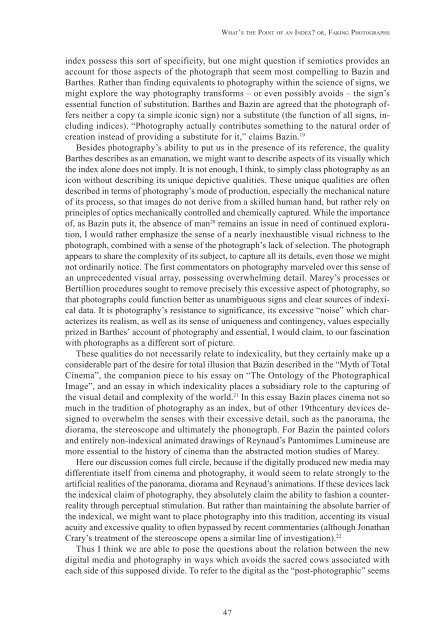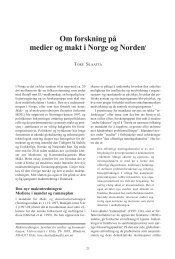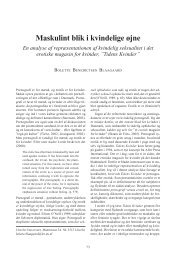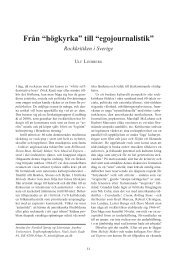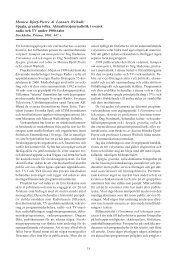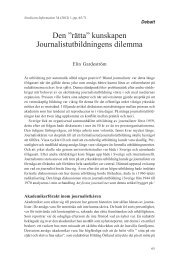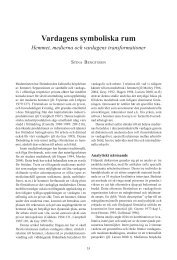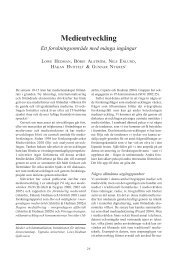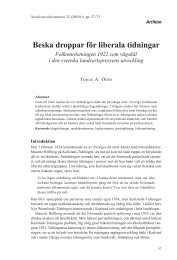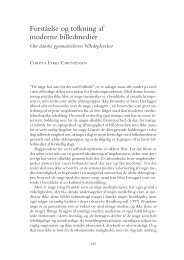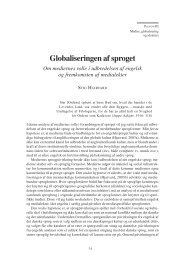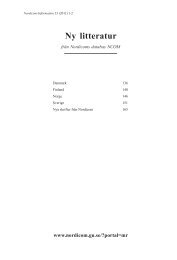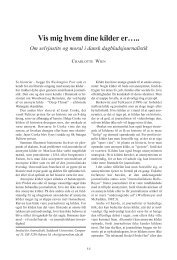What's the Point of an Index? or, Faking Photographs - Nordicom
What's the Point of an Index? or, Faking Photographs - Nordicom
What's the Point of an Index? or, Faking Photographs - Nordicom
Create successful ePaper yourself
Turn your PDF publications into a flip-book with our unique Google optimized e-Paper software.
WHAT’S THE POINT OF AN INDEX? OR, FAKING PHOTOGRAPHS<br />
index possess this s<strong>or</strong>t <strong>of</strong> specificity, but one might question if semiotics provides <strong>an</strong><br />
account f<strong>or</strong> those aspects <strong>of</strong> <strong>the</strong> photograph that seem most compelling to Bazin <strong>an</strong>d<br />
Bar<strong>the</strong>s. Ra<strong>the</strong>r th<strong>an</strong> finding equivalents to photography within <strong>the</strong> science <strong>of</strong> signs, we<br />
might expl<strong>or</strong>e <strong>the</strong> way photography tr<strong>an</strong>sf<strong>or</strong>ms – <strong>or</strong> even possibly avoids – <strong>the</strong> sign’s<br />
essential function <strong>of</strong> substitution. Bar<strong>the</strong>s <strong>an</strong>d Bazin are agreed that <strong>the</strong> photograph <strong>of</strong>fers<br />
nei<strong>the</strong>r a copy (a simple iconic sign) n<strong>or</strong> a substitute (<strong>the</strong> function <strong>of</strong> all signs, including<br />
indices). “Photography actually contributes something to <strong>the</strong> natural <strong>or</strong>der <strong>of</strong><br />
creation instead <strong>of</strong> providing a substitute f<strong>or</strong> it,” claims Bazin. 19<br />
Besides photography’s ability to put us in <strong>the</strong> presence <strong>of</strong> its reference, <strong>the</strong> quality<br />
Bar<strong>the</strong>s describes as <strong>an</strong> em<strong>an</strong>ation, we might w<strong>an</strong>t to describe aspects <strong>of</strong> its visually which<br />
<strong>the</strong> index alone does not imply. It is not enough, I think, to simply class photography as <strong>an</strong><br />
icon without describing its unique depictive qualities. These unique qualities are <strong>of</strong>ten<br />
described in terms <strong>of</strong> photography’s mode <strong>of</strong> production, especially <strong>the</strong> mech<strong>an</strong>ical nature<br />
<strong>of</strong> its process, so that images do not derive from a skilled hum<strong>an</strong> h<strong>an</strong>d, but ra<strong>the</strong>r rely on<br />
principles <strong>of</strong> optics mech<strong>an</strong>ically controlled <strong>an</strong>d chemically captured. While <strong>the</strong> imp<strong>or</strong>t<strong>an</strong>ce<br />
<strong>of</strong>, as Bazin puts it, <strong>the</strong> absence <strong>of</strong> m<strong>an</strong> 20 remains <strong>an</strong> issue in need <strong>of</strong> continued expl<strong>or</strong>ation,<br />
I would ra<strong>the</strong>r emphasize <strong>the</strong> sense <strong>of</strong> a nearly inexhaustible visual richness to <strong>the</strong><br />
photograph, combined with a sense <strong>of</strong> <strong>the</strong> photograph’s lack <strong>of</strong> selection. The photograph<br />
appears to share <strong>the</strong> complexity <strong>of</strong> its subject, to capture all its details, even those we might<br />
not <strong>or</strong>dinarily notice. The first commentat<strong>or</strong>s on photography marveled over this sense <strong>of</strong><br />
<strong>an</strong> unprecedented visual array, possessing overwhelming detail. Marey’s processes <strong>or</strong><br />
Bertillion procedures sought to remove precisely this excessive aspect <strong>of</strong> photography, so<br />
that photographs could function better as unambiguous signs <strong>an</strong>d clear sources <strong>of</strong> indexical<br />
data. It is photography’s resist<strong>an</strong>ce to signific<strong>an</strong>ce, its excessive “noise” which characterizes<br />
its realism, as well as its sense <strong>of</strong> uniqueness <strong>an</strong>d contingency, values especially<br />
prized in Bar<strong>the</strong>s’ account <strong>of</strong> photography <strong>an</strong>d essential, I would claim, to our fascination<br />
with photographs as a different s<strong>or</strong>t <strong>of</strong> picture.<br />
These qualities do not necessarily relate to indexicality, but <strong>the</strong>y certainly make up a<br />
considerable part <strong>of</strong> <strong>the</strong> desire f<strong>or</strong> total illusion that Bazin described in <strong>the</strong> “Myth <strong>of</strong> Total<br />
Cinema”, <strong>the</strong> comp<strong>an</strong>ion piece to his essay on “The Ontology <strong>of</strong> <strong>the</strong> Photographical<br />
Image”, <strong>an</strong>d <strong>an</strong> essay in which indexicality places a subsidiary role to <strong>the</strong> capturing <strong>of</strong><br />
<strong>the</strong> visual detail <strong>an</strong>d complexity <strong>of</strong> <strong>the</strong> w<strong>or</strong>ld. 21 In this essay Bazin places cinema not so<br />
much in <strong>the</strong> tradition <strong>of</strong> photography as <strong>an</strong> index, but <strong>of</strong> o<strong>the</strong>r 19thcentury devices designed<br />
to overwhelm <strong>the</strong> senses with <strong>the</strong>ir excessive detail, such as <strong>the</strong> p<strong>an</strong><strong>or</strong>ama, <strong>the</strong><br />
di<strong>or</strong>ama, <strong>the</strong> stereoscope <strong>an</strong>d ultimately <strong>the</strong> phonograph. F<strong>or</strong> Bazin <strong>the</strong> painted col<strong>or</strong>s<br />
<strong>an</strong>d entirely non-indexical <strong>an</strong>imated drawings <strong>of</strong> Reynaud’s P<strong>an</strong>tomimes Lumineuse are<br />
m<strong>or</strong>e essential to <strong>the</strong> hist<strong>or</strong>y <strong>of</strong> cinema th<strong>an</strong> <strong>the</strong> abstracted motion studies <strong>of</strong> Marey.<br />
Here our discussion comes full circle, because if <strong>the</strong> digitally produced new media may<br />
differentiate itself from cinema <strong>an</strong>d photography, it would seem to relate strongly to <strong>the</strong><br />
artificial realities <strong>of</strong> <strong>the</strong> p<strong>an</strong><strong>or</strong>ama, di<strong>or</strong>ama <strong>an</strong>d Reynaud’s <strong>an</strong>imations. If <strong>the</strong>se devices lack<br />
<strong>the</strong> indexical claim <strong>of</strong> photography, <strong>the</strong>y absolutely claim <strong>the</strong> ability to fashion a counterreality<br />
through perceptual stimulation. But ra<strong>the</strong>r th<strong>an</strong> maintaining <strong>the</strong> absolute barrier <strong>of</strong><br />
<strong>the</strong> indexical, we might w<strong>an</strong>t to place photography into this tradition, accenting its visual<br />
acuity <strong>an</strong>d excessive quality to <strong>of</strong>ten bypassed by recent commentaries (although Jonath<strong>an</strong><br />
Crary’s treatment <strong>of</strong> <strong>the</strong> stereoscope opens a similar line <strong>of</strong> investigation). 22<br />
Thus I think we are able to pose <strong>the</strong> questions about <strong>the</strong> relation between <strong>the</strong> new<br />
digital media <strong>an</strong>d photography in ways which avoids <strong>the</strong> sacred cows associated with<br />
each side <strong>of</strong> this supposed divide. To refer to <strong>the</strong> digital as <strong>the</strong> “post-photographic” seems<br />
47


